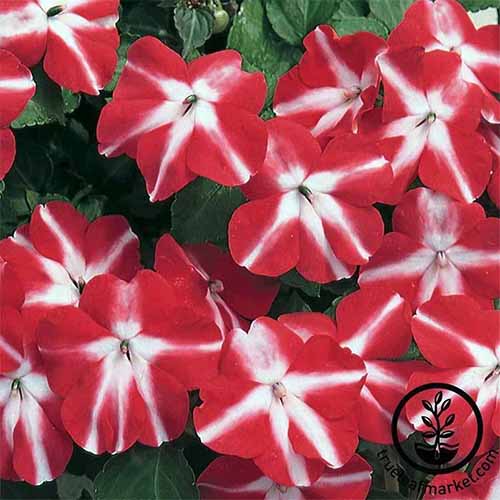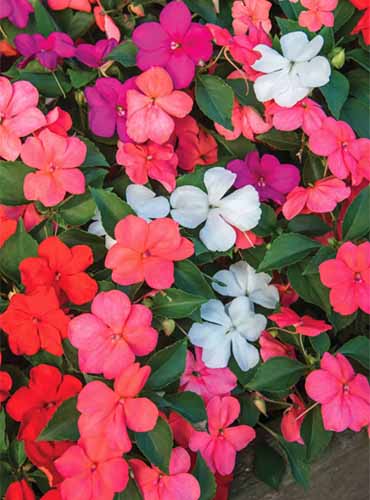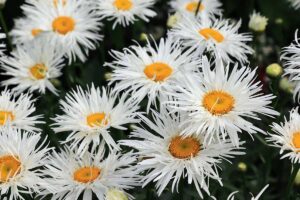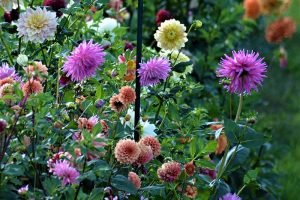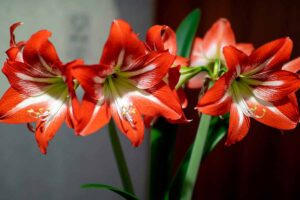Impatiens walleriana
Impatiens are famous for their ability to liven up a shady corner of the yard.
Even deep shade doesn’t phase them much. And we aren’t talking about adding just a bit of greenery to a shady spot. Oh no, we’re talking vibrant mounds of pink, white, and purple.
Apparently, there are a lot of people who are looking to add easygoing color to their shady spots, because impatiens used to be the most popular bedding plant in the US.

We link to vendors to help you find relevant products. If you buy from one of our links, we may earn a commission.
But during the early 2010s, impatiens started to fall out of favor because they were hit so hard by downy mildew.
Instead of being the old shade-brightening reliable we know and love, the bedding plants that were a standby in nurseries started to become a liability throughout the majority of North America.
Now, pretty impatiens are ready for their comeback thanks to new cultivars and preventative techniques that growers are implementing.
What You’ll Learn
Ready to find out how you can bring impatiens to your space? Let’s dig in!
Cultivation and History
The ornamental impatiens (Impatiens walleriana) that we know and love are originally from eastern Africa, though other species in the genus are native to Asia or North America.
Impatiens are sometimes called jewelweed, busy Lizzie, patience, or touch-me-not.
Impatiens is a reference to the plant’s impatient nature. It’s a Latin word that describes the method by which the plant reseeds itself. When the seeds are ready, they explode in a firecracker-like burst at the slightest touch.
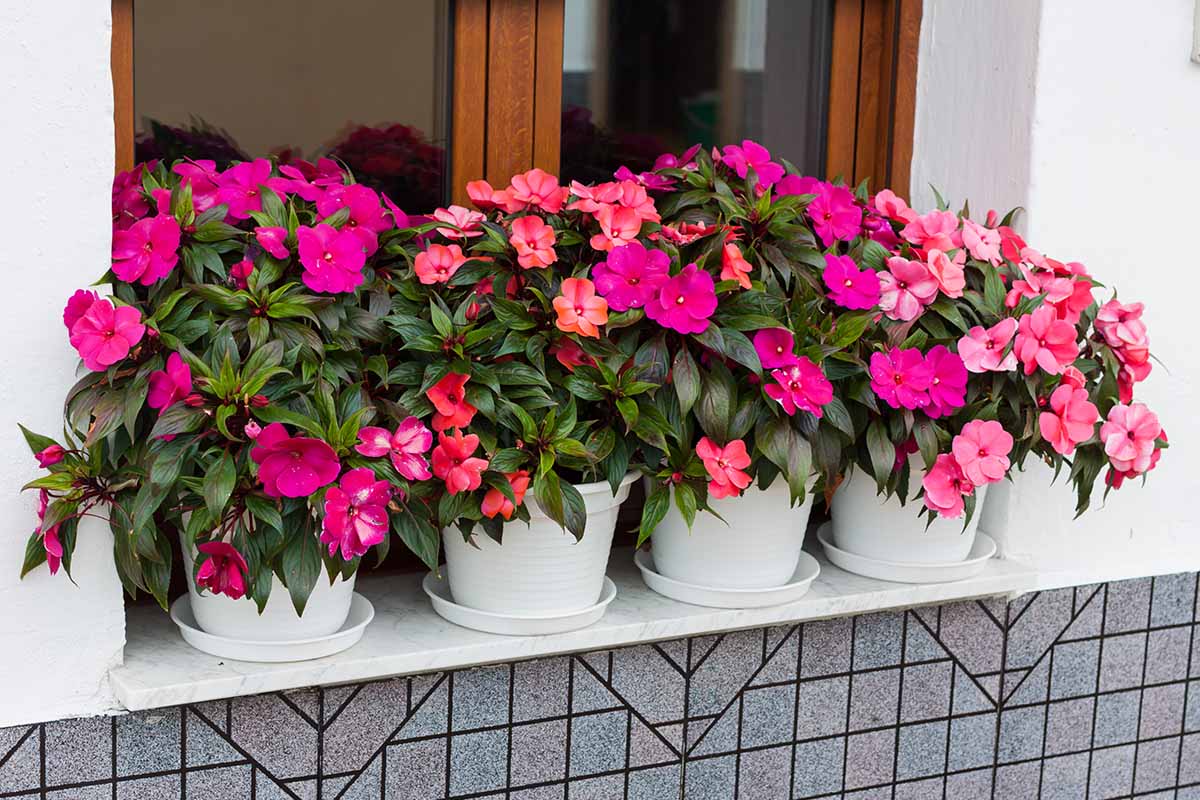
There are many plants in the genus, including:
- Kashmir balsam (I. balfourii)
- Garden balsam (I. balsamina)
- Spotted jewelweed (I. capensis)
- New Guinea impatiens (I. hawkeri)
- Poor man’s rhododendron (I. sodenii)
- Touch-me-not (I. pallida).
Flowers can be orange, pink, purple, red, violet, yellow, and white, and many shades in between.
Impatiens can grow anywhere from 10 inches to three feet tall, depending on the cultivar.
Propagation
Busy Lizzies are one of those plants that grow super easily from seed, but you can also propagate them by rooting cuttings.
They’re also usually available at nurseries in multipacks that are extremely affordable.
From Seed
Seeds should be started indoors 12 weeks before the last projected frost date. Prepare a seed tray by filling it with a seed-starting medium. Gently sprinkle the seeds over the medium. Don’t bury them, because they need light to germinate.
Spray the medium using a water bottle and cover with a piece of glass or clear plastic. Keep the soil moist as the seeds germinate. That means opening the cover and spraying before the soil begins to dry out.
Keep the tray in bright, indirect sunlight. The seeds should sprout in two to three weeks. Once they’ve emerged, you can remove the cover. Thin the seedlings so they’re no closer than two inches apart in any direction.
Once two true leaves have formed, you can move the tray outside to harden the seedlings off. Keep the tray in a protected spot without direct sunlight for an hour.
On the following day, add an hour before bringing them back inside. Each day, add another hour until they can stay outside all day.
Here’s a quick tip for the lazy gardener: If you live somewhere that doesn’t experience freezing temperatures below 32°F, you can allow plants that are growing in your garden to go to seed at the end of the season.
Gently touch the seedpods when they’re mature. They will explode everywhere, sending seeds out into your garden bed. Next year, as long as conditions are favorable, you’ll likely have new seedlings that pop up on their own.
From Cuttings
You can easily propagate impatiens by rooting cuttings as well.
Cut a stem that is about three inches long and remove all but two leaves. Dip the cut end in rooting hormone powder or gel and insert the cutting into a pot filled with seed-starting mix. Water the medium so that it is moist but not soggy.
Tent a clear plastic bag over the cutting and place it in a spot with bright, indirect light. Check once a day to ensure that the soil is still moist. Add water if necessary.
New roots should form within a few weeks. Give the cutting a gentle tug. If it resists, you have succeeded! Harden off the cutting as described above for seedlings and plant it into the ground.
If it doesn’t resist after a few weeks, it likely won’t root. Toss it and start again.
From Seedlings/Transplanting
Impatiens are one of the cheapest annuals available at the store. You can usually buy a six-pack of them for a few bucks, and you can often find them even cheaper towards the end of spring.
Once you bring them home, prepare the garden for planting. You can plant as soon as the last projected frost date for your area has passed in the spring.

The first step is to ensure that you have the kind of soil that impatiens love. They want something rich, loamy, and well-draining but water-retentive.
Most of us don’t have that kind of soil naturally, so the best way to create it is to add lots of well-rotted compost to the soil. Compost helps to improve both sandy and heavy clay earth.
Dig a hole about the same depth and twice as wide as the container that the plant came in and remove it from the container. Gently loosen the roots and place the plant in the hole. Backfill with soil and water well.
Transplants should be spaced about 12 inches apart. The closer you plant them, the taller the individual plants will grow.
How to Grow
Ideally, you should situate your plants somewhere that they’ll receive a few hours of sunlight first thing in the morning.
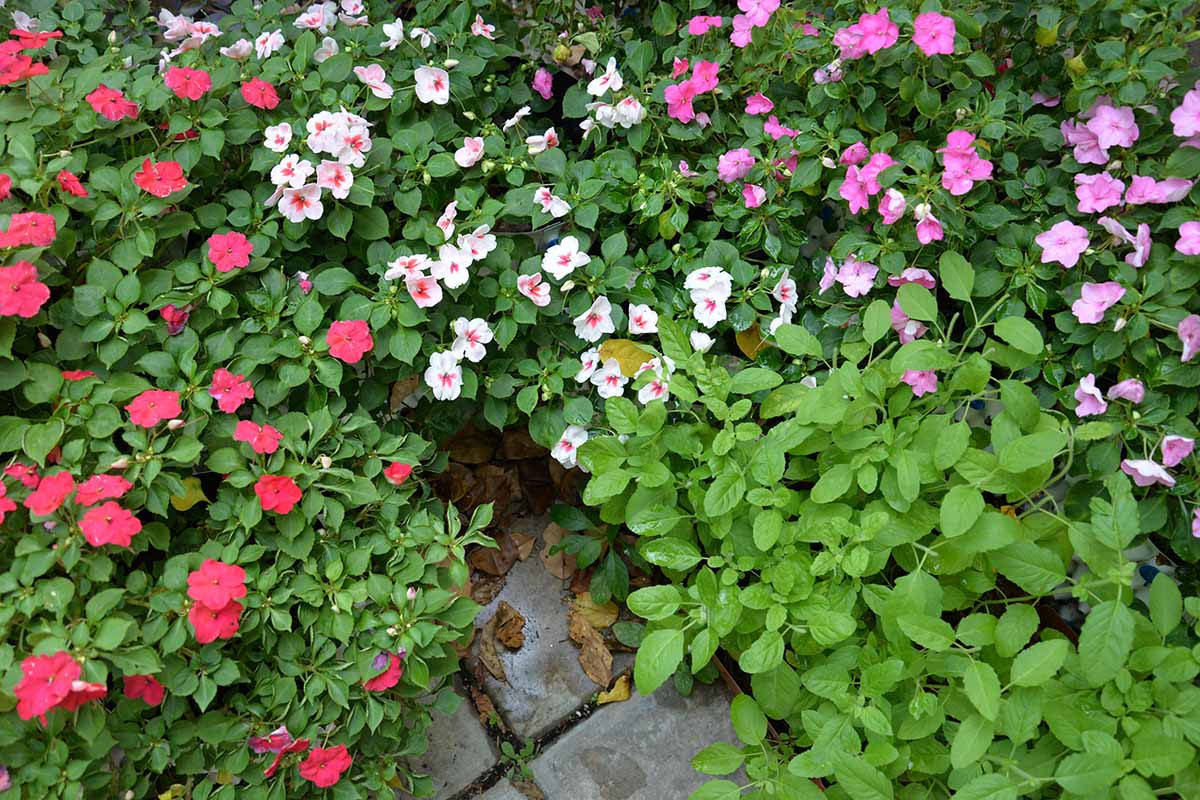
Afternoon sun is too harsh, though dappled sunlight is fine. If you plant them in full, deep shade, they’ll survive, but the blossoms will be reduced in size and number.
Touch-me-nots need a lot of water. The soil shouldn’t dry out too much, and that’s part of the reason why they don’t do well in full sun – they tend to dry out too quickly.
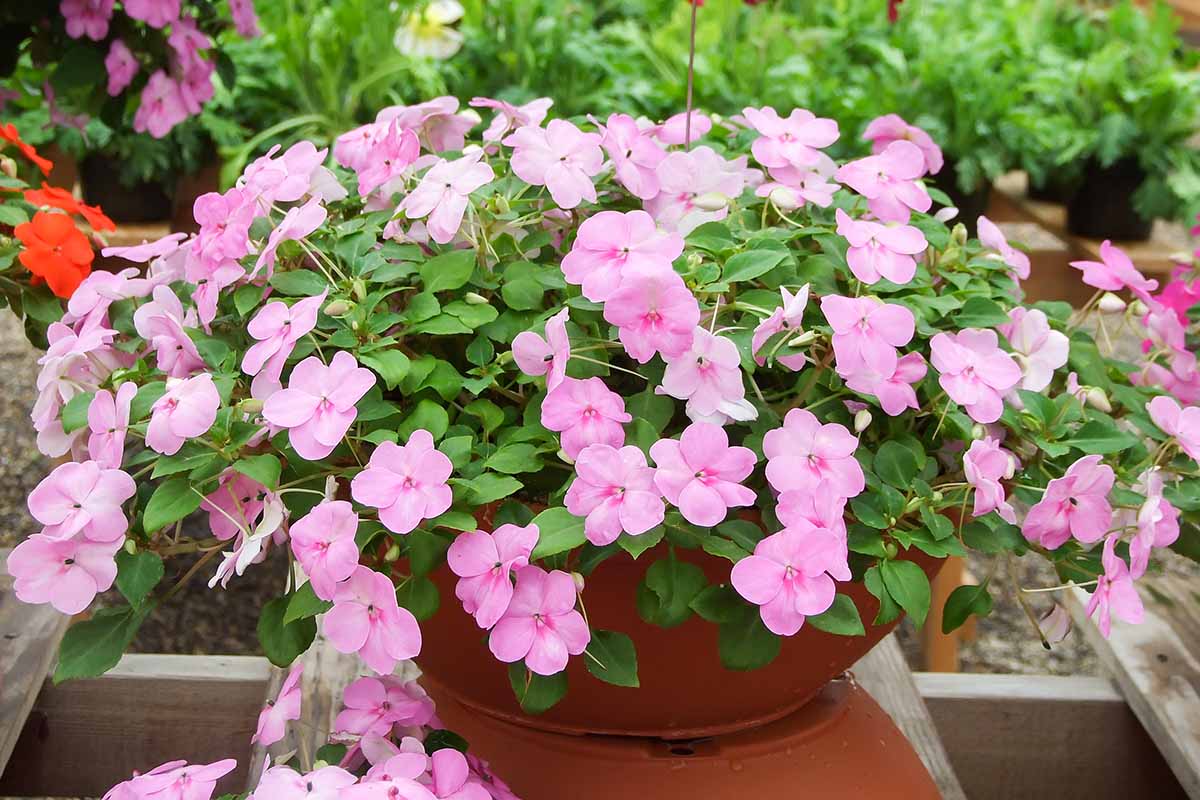
When the surface of the soil begins to dry, add more water. If the plants start to droop, you’ve waited too long.
Feed the plants with a flower-specific fertilizer once a month, after the flower buds have formed.
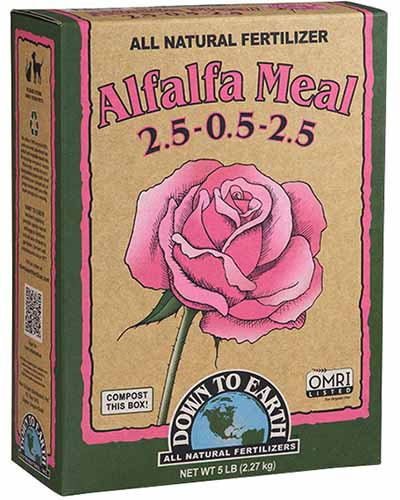
Alfalfa Meal from Down to Earth is an excellent option. Arbico Organics carries half- and five-pound boxes.
Growing Tips
- Plant in partial sun or partial shade.
- Keep the soil moist.
- Fertilize once a month with flower fertilizer.
- Try growing them as a houseplant for year-round color.
- They can be grown under black walnuts and other trees that produce juglone.
Maintenance
No doubt part of the reason impatiens are so popular is because they need hardly any maintenance to look fabulous. They are self-cleaning, which means you don’t need to remove the spent flowers to see new blossoms.
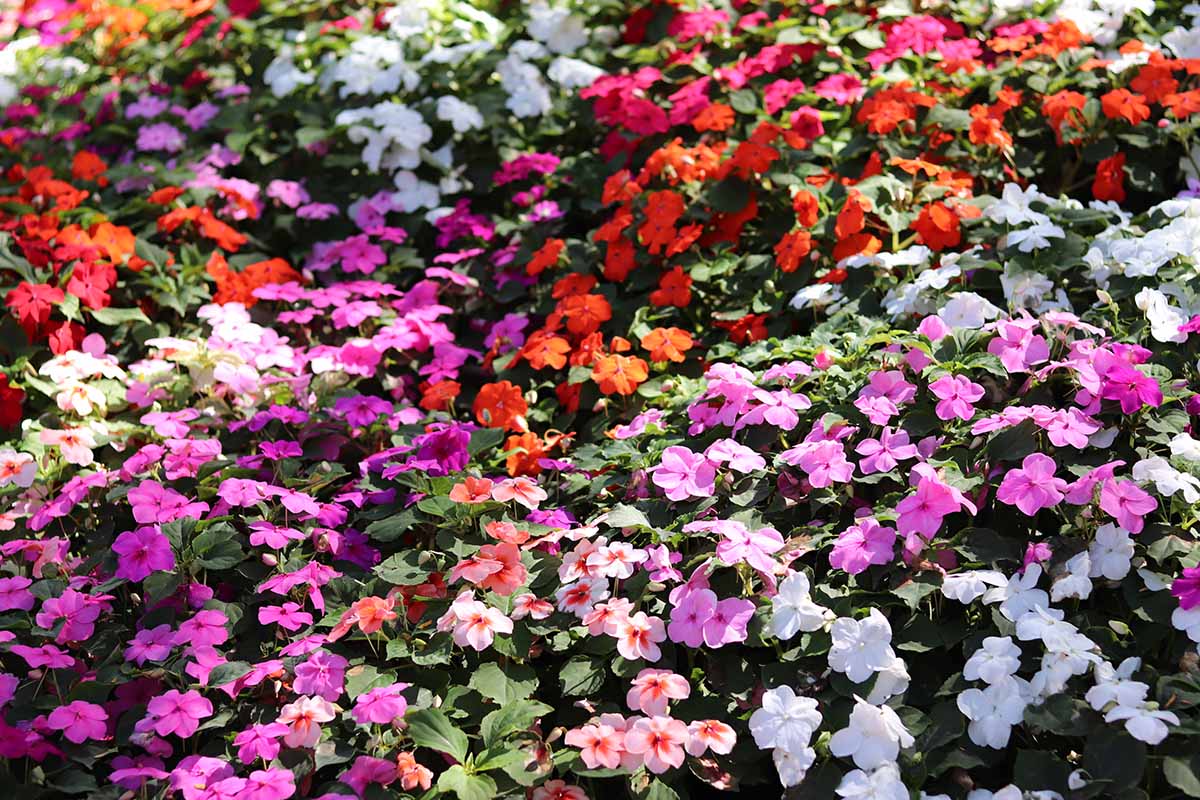
You don’t need to pinch them back, either. They have a naturally bushy, compact shape without any effort on your part. However, feel free to pinch away if you want – it won’t hurt anything.
Cultivars to Select
Impatiens are usually grouped according to series, which is a marketing term used to group collections of plants with similar characteristics.
These will usually share the same growth habit and cultural requirements while being different from one cultivar to the next in terms of color, or patterns seen on the flowers.
Accent
The name is on the nose with this series from Syngenta. These dwarf plants produce relatively massive flowers in comparison to other varieties, which makes them the perfect garden accent.
These reach a height of 10 to 12 inches and spread 10 inches. The large flowers are up to two inches across, and seeds mature in 70 to 77 days.
You’ll find Accent series cultivars in red, pink, orange, salmon, lilac, violet, and white, as well as ‘Peppermint Mix’ (a combo of pinkish-red and white flowers) and other seed mixes, plus unique ‘Star’ cultivars with red, orange, violet, or salmon-colored blossoms that have white star-shaped centers.
Accent ‘Red Star’ seeds and a variety of other color options are available in packages of 500 from True Leaf Market.
Beacon
The Beacon series comes to us from PanAmerican Seed Company, and this flower was bred to be resistant to downy mildew.
It was first introduced in 2020 and can now be found across the country thanks to its ability to withstand this widespread disease.
The seedlings tend to cost more than other cultivars, but the price will be well worth it when your touch-me-nots make it through the season unscathed.
These hardy flowers are available in red, violet, salmon, coral, orange, rose, and white. The plants grow 14 to 18 inches in height and spread 12 to 14 inches.
Beacon ‘Paradise’ Mix is available from Burpee in packets of 25 seeds or bundles of 24 live plants in a mix of colors including white, red, coral, and violet.
Imara XDR
Imara is a name that symbolizes strength, but what’s with the “XDR”?
It stands for extra disease resistance, with thrilling flowers to boot! This series, which was introduced in 2019 by Syngenta Flowers, is highly resistant to downy mildew.
With cultivars in red, orange, pink, purple, salmon, rose, and white, as well as mixes and colorful options with white stars at their centers, the plants have a height and spread of 10 to 12 inches.

Seeds are available from the Park Seeds Store in packs of 30 via Amazon. This mix includes a variety of solid-color cultivars.
Managing Pests and Disease
Impatiens are mostly at risk of damage or illness caused by herbivores and downy mildew, but there are a few other things you should keep an eye out for as well.
Herbivores
Impatiens blossoms are edible, and if you’ve ever taken a nibble, you might be surprised by how sweet they are. Unfortunately, herbivores have figured out how tasty they are, too.
Deer
Deer love impatiens. If you have deer in your area, they’ll thank you for the dessert buffet that you’ve provided for them.
If you come outside and your plants are mowed down to the ground, these animals are likely the culprit.
Our guide to dealing with deer can help.
Rabbits
Just like deer, rabbits adore these flowers and they’ll chomp on them before they choose to go for many other options in your garden.
Rather than mowing your impatiens beds down as deer do, they tend to chew off individual leaves and petals as they move through the garden.
We have an article to walk you through protecting your plants from rabbits.
Insects and Mites
Insect pests as well as mites aren’t a common problem for your plants unless they’re stressed. But underwatering in particular makes them vulnerable.
Aphids
While many species of aphids may feed on impatiens, the tiny, yellow melon aphid (Aphis gossypii) is the most common.
Because they’re so small, you probably won’t spot the insects first. Instead, you’ll notice yellow leaves and stunted growth.
However, this only happens if an infestation is fairly large, and a significant infestation will generally occur only when plants are stressed.
If you keep your impatiens happy by planting them in the right conditions and feeding and watering as needed, a few aphids aren’t a big deal, and they don’t warrant cause for concern.
For tips on identifying and addressing an aphid situation, check out our comprehensive guide.
Spider Mites
The two-spotted spider mite (Tetranychus urticae) is an extremely common garden visitor.
These tiny arachnids tend to prefer dry, warm conditions, so impatiens that are kept moist are less prone to infestation, and robust plants are also less likely to succumb to an infestation if these pests become a problem.
If spider mites are feeding on your impatiens, you’ll see fine webbing on the plants and yellowing leaves. The blossoms might be small or distorted.
As with aphids, we have an excellent guide to help you identify and control a situation with spider mites.
Thrips
Thrips are tiny winged insects that use their mouthparts to pierce the stems and leaves of plants and suck the juice out.
This causes the flowers and young leaves to emerge distorted, and stippling may be seen on existing foliage. They can also spread nasty diseases.
The western flower thrip (Frankliniella occidentalis) is yellow, medium brown, or dark brown. These insects are thin and about one millimeter long.
Our guide to thrips can help you wrestle an infestation under control.
Disease
There are several diseases that impact impatiens, but downy mildew is the one you really need to be careful about.
Bacterial Leaf Spot
Bacterial leaf spot or soft rot is a generic term for disease that may be caused by several different types of bacteria in the Erwinia, Pseudomonas, and Xanthomonas genera.
These can cause water-soaked blotches or spots on the foliage and stems of plants, and there is no known cure.
You’ll typically see brown, soggy stems or leaves. If you’re in the habit of examining your plants closely every week or so, the initial symptoms are brown spots on the foliage.
These spots eventually merge together and the leaves turn soft and mushy later, as the disease progresses and spreads.
The problem is most common in wet conditions, especially when you sprinkle water on the foliage rather than watering at the soil level. It may also occur if the soil doesn’t drain well.
That’s why you should be sure to plant in well-draining soil. And water the soil, not the plants. Remove any infected foliage or affected plants in their entirety, if necessary.
Downy Mildew
Impatiens downy mildew (IDW) made growing these plants a challenge for the past decade or so. The plants are extremely susceptible and the conditions they like to grow in are perfect for downy mildew to thrive.
These days, you can find many resistant cultivars, and many commercial growers use a preventative fungicide before they ship plants to stores, but it’s something you should definitely still be aware of.
Dr. Mary Hasubeck and her team at the Floriculture & Nursery Research Initiative at Michigan State University determined that treating impatiens before they leave the nursery with a fungicide called Segovis prevents the disease from taking hold, even if the plants are never treated again.
These days, many growers are using this technique to ensure delivery of healthy plants.
Several cultivars and hybrids have also been bred to be more resistant to IDM. Even so, the prevalence of this disease continues to be a problem.
IDW is caused by the water mold Plasmopara obducens, and once it infects your plants, there is no cure.
You won’t be able to grow impatiens in the same area for years. If you see silvery-white mold on the undersides of the leaves, pull your plants right away.
If you must have some sort of impatiens in your yard after experiencing downy mildew, New Guineas are immune to IDW, so you might try growing this species next year instead.
See our guide to New Guinea impatiens for growing tips.
Fasciation and Leaf Galls
When fasciation strikes your flower patch, your plants are definitely not in for a good time. It makes the vegetative growth on your impatiens look strange and can ruin the floral display.
It’s caused by a bacteria called Rhodococcus fascians and results in swollen stems that might be fused, twisted, and flat.
Leaves might be small and distorted, and blossoms may not form or they’ll be deformed and small. You may also see galls on the leaves.
Unfortunately, there is no known cure. All you can do is pull the plants if they’re infected.
Impatiens Necrotic Spot Virus
Impatiens necrotic spot virus (INSV) is related to tomato spotted wilt virus (TSWV). It’s spread by thrips, which is why it’s important to try to prevent infestations or control these pests as needed.
It can be hard to diagnose this disease, because the symptoms are so variable. It can cause the plant to wilt or turn yellow, or you may see stunted flower growth, stunted vegetative growth, spots on leaves, or dying stems.
The only way to be sure your plants have been infected with this virus is to send a sample to your local extension office.
If the test comes back positive, you will need to pull all your plants and dispose of them. This pathogen can infect other plants besides impatiens, and you don’t want it to spread.
Verticillium Wilt
Caused by the fungi Verticillium dahliae and V. also-atrum, this disease attacks many different herbaceous plants, causing wilted and yellowing leaves.
The yellowing starts on the edges and between the veins before expanding to the entire leaf. Eventually, the leaves turn brown and die off.
There isn’t any treatment known to be effective against verticillium, and once your plants have it, it’s in your soil too. Other plants placed in the area in the future might be infected.
You can pull the plants to prevent it from spreading, or trim away the infected foliage and hope that your impatiens continue to provide a nice display for the rest of the season.
At the end of the year, remove all the plants and any debris. Dispose of all infected foliage and plant waste in the garbage rather than on your compost pile.
Best Uses
Impatiens shine as a bedding plant, especially in big groups when planted en masse. They also work well as a border option or in containers like window boxes or hanging planters.

You can grow impatiens under trees, though you shouldn’t place them where tree roots are positioned near the surface of the soil.
Don’t forget that you can eat the flowers, as long as they haven’t been treated with any chemicals. Try them as a topping for salad or ice cream.
Quick Reference Growing Guide
| Plant Type: | Annual flower | Flower / Foliage Color: | Orange, pink, purple, red, violet, yellow, white/green |
| Native to: | Eastern Africa | Tolerance: | Shade |
| Hardiness (USDA Zone): | 2-11 | Soil Type: | Rich, loamy |
| Bloom Time: | Spring, summer, fall | Soil pH: | 5.5-6.5 |
| Exposure: | Partial sun, partial shade | Soil Drainage: | Well-draining |
| Time to Maturity: | 12 weeks | Maintenance: | Low |
| Spacing: | 12 inches | Attracts: | Bees, butterflies |
| Planting Depth: | Soil surface (seeds), same depth as container (transplants) | Companion Planting: | Columbine, begonias, rhododendrons |
| Height: | Up to 3 feet | Uses: | Bedding, borders, containers |
| Spread: | Up to 1 foot | Order: | Ericales |
| Growth Rate: | Moderate | Family: | Balsaminaceae |
| Water Needs: | High | Genus: | Impatiens |
| Common Pests and Diseases: | Deer, rabbits; aphids, spider mites, thrips; bacterial leaf spot, downy mildew, fasciation, impatiens necrotic spot virus, verticillium wilt | Species: | Walleriana |
Impatiens Are Ready for Their Big Comeback
Impatiens once seemed unstoppable. But for most of the past decade, they have become less and less popular because of the awful downy mildew plague sweeping through nurseries and gardens in the UK and North America.
That’s a shame, because this is such a low-maintenance, impressive plant that can fill up shady containers, and those hard-to-fill spots under trees and on the north sides of buildings.
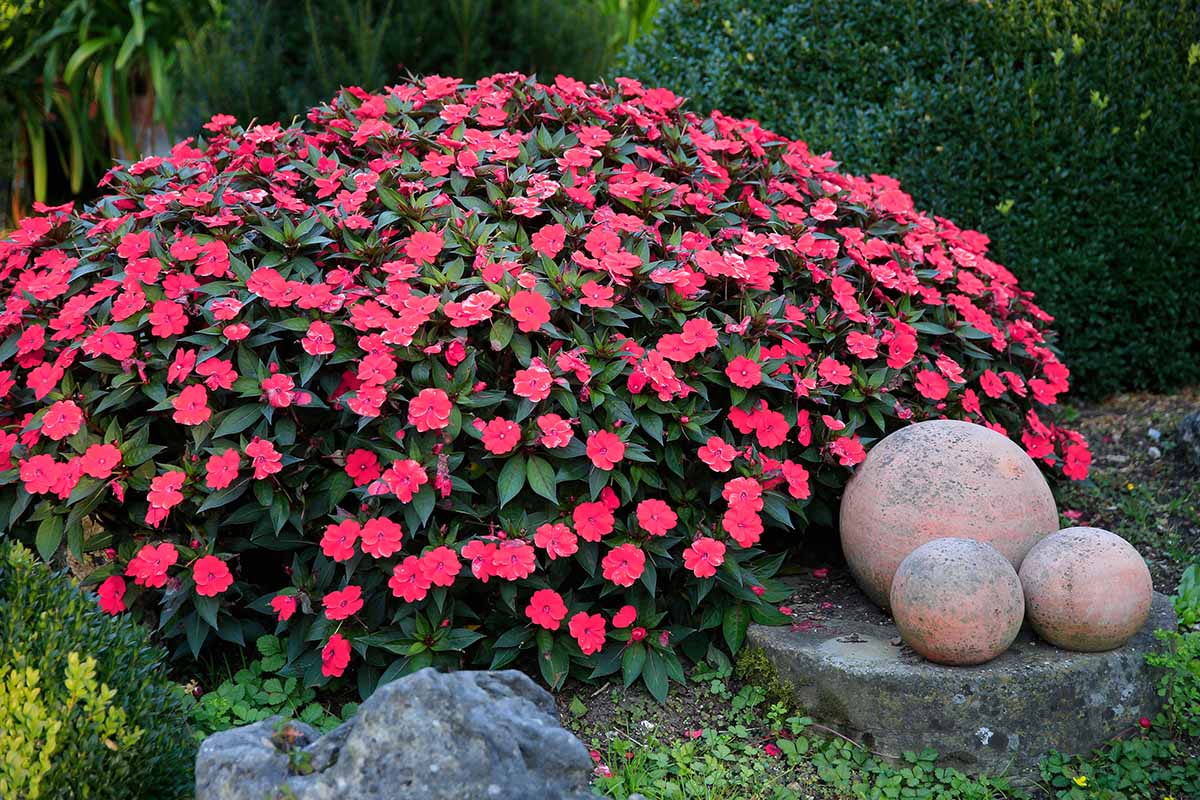
Fortunately, this beauty is ready to make its comeback. With smart growing techniques and resistant hybrids and cultivars, you can once again feel safe adding busy Lizzies to your garden.
Did you give up growing impatiens because of downy mildew? Which cultivars are you using in your garden this year? Let us know in the comments!
Ready to learn about some other shade options for your flower garden? You might find the following guides useful:
